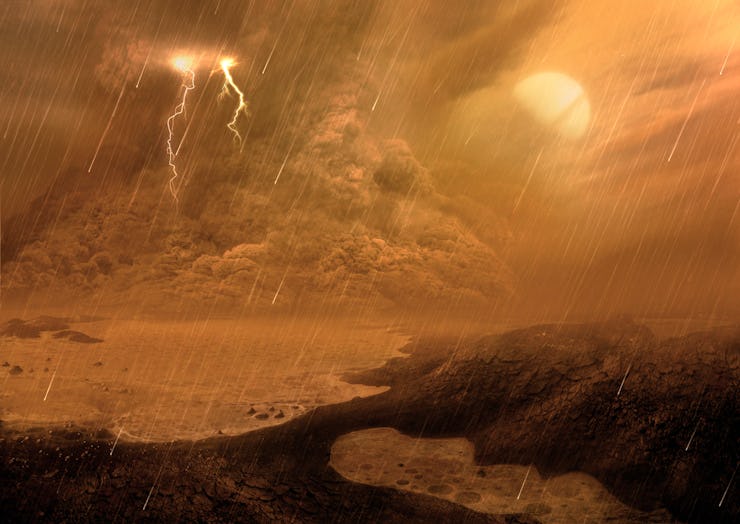An Upcoming NASA Mission to Saturn’s Largest Moon Could Find Chemicals Key to Alien Life
The Dragonfly quadcopter's future landing site on Titan may once have been a warm oasis of liquid water amid the moon's icy hydrocarbon landscape.

On Titan’s icy surface, liquid water could have filled the bottom of Selk Crater for tens of thousands of years after the ancient impact that formed it.
When NASA’s Dragonfly spacecraft arrives on Saturn’s moon Titan in 2034, it will explore the area around Selk Crater, an impact crater just north of Titan’s equator. Selk Crater is interesting because at some point in Titan’s hazy past, there was probably liquid water there — and it probably had the chance to interact with hydrocarbons to, just maybe, form some of the building blocks of life. The ancient comet impact that formed Selk Crater would have melted water and kickstarted a series of chemical reactions that could have produced the chemicals that gave rise to life on Earth.
But a recent study, published online as a non-peer-reviewed preprint, suggests that liquid water may have existed at Dragonfly’s landing site for even longer than planetary scientists expected — much, much longer. And that dramatically increases the odds that Dragonfly, whose mission is to search for the chemical ingredients for life, could find something interesting.
The Secret is In the Crust
Massachusetts Institute of Technology planetary scientist Shigeru Wakita and his colleagues recently simulated what would happen on Titan if a comet big enough to create Selk Crater crashed into the methane-shrouded moon. The answer depends on exactly what Titan’s icy crust is made of. If it’s frozen water all the way down, then the ice melted by the heat and pressure of the impact would probably take several centuries to re-freeze into solid ice again.
But Wakita and his colleagues wanted to know what would happen if the “bedrock” on Titan is actually a type of ice called methane clathrate: mostly water ice, but with molecules of methane trapped in its crystalline structure. (It’s also called “fire ice,” because if you set it on fire, the methane burns while the water ice melts — and that’s science you can use!)
A photo of ice and fire.
“There are two interesting works on methane clathrate. One indicated that methane clathrate is stronger than water ice, and another showed methane clathrate can be an insulator. Both are important for the crater formation,” Wakita tells Inverse.
In other words, if there are a few meters of fire ice lying on top of the ordinary water ice that makes up much of Titan’s upper crust, then two things happen. First, when a comet slams into Titan’s surface, melting several layers of ice with the heat and pressure of its impact, then the stronger methane clathrate means the pool of melted ice will be deeper and differently shaped than if the comet had just hit pure water ice.
“It's deeper than previous estimates,” says Wakita. “Moreover, its torus shape is more complicated than expected.” (A torus is what physicists call the shape of a donut — more science you can use!)
Second, because methane clathrate is a better insulator than pure water ice, the melted ice is likely to stay liquid much longer. Wakita and his colleagues' simulations predicted a 10-kilometer-wide, three-kilometer-deep melt pool at the bottom of Selk Crater lasting somewhere between 5,000 and 90,000 years.
That’s a pretty wide range of possibilities, but even 5,000 years is a huge leap compared to previous estimates of just a few centuries. However, if you have a pool of liquid water and hydrocarbons like methane, it takes only a few years for chemical reactions to start building molecules like amino acids, the molecules that combine to form proteins.
“The longer the liquid water remains, the more time the system has to produce more complex molecules,” write Wakita and his colleagues in their recent paper. Those more complex molecules could include things like enzymes, building blocks for DNA, the lipids that form cell membranes, or maybe even life itself.
Artist rendering of a NASA Dragonfly lander spacecraft exploring the surface of Titan, a moon of the planet Saturn. Also visible is a lake of iquid methane, which might serve as a fuel source for any potential spacecraft. (Illustration by Adrian Mann/Future Publishing via Getty Images)
What’s Next?
Of course, we won’t know for sure what was sloshing around in Selk Crater’s long-ago melt pool until Dragonfly arrives and tests the local ice with DraMS (the Dragonfly Mass Spectrometer). In the meantime, Wakita and his colleagues say, simulations could help planetary scientists better understand how long complex organic molecules — molecules that contain some combination of carbon, hydrogen, and nitrogen — could last in the crater’s melt pool, as well as how much of those chemicals could have actually mixed with liquid water there.
Meanwhile, Wakita and his colleagues want to investigate how impacts like the one that formed Selk Crater could have given rise to Titan’s notoriously hazy hydrocarbon atmosphere.
“Understanding the process of releasing methane via impacts is our next step. Melt of methane clathrate is sure to release the methane as a gas phase,” Wakita says. “And even if it’s not melted, methane gas can be released from the methane clathrate. Our next work will help to understand the supplying process of the methane into Titan's dense atmosphere.”